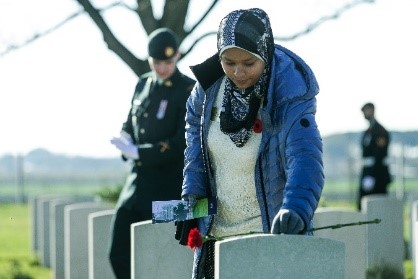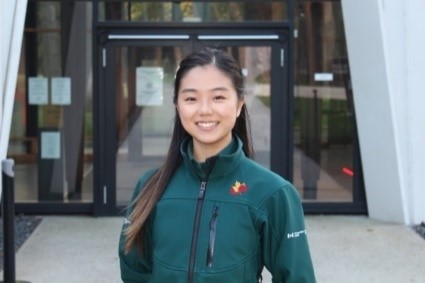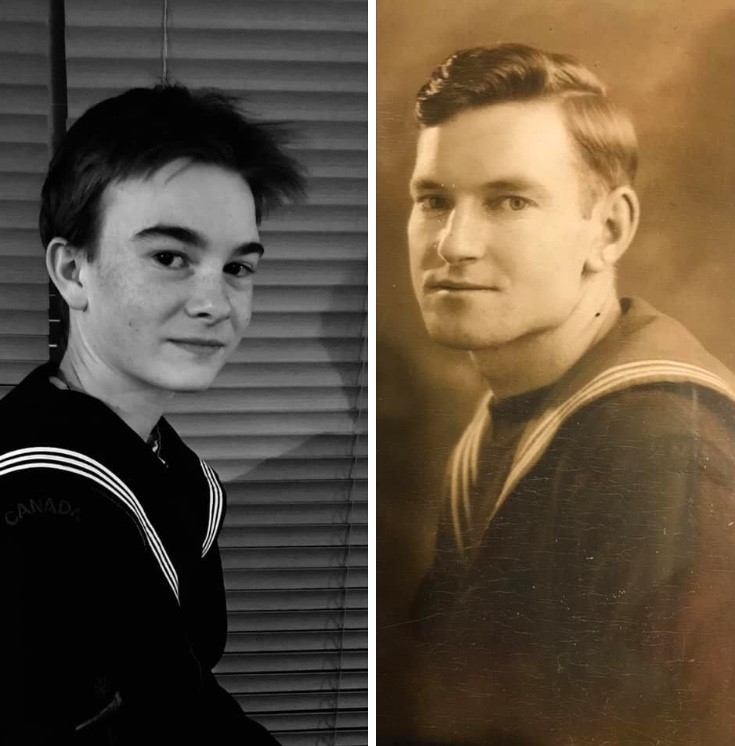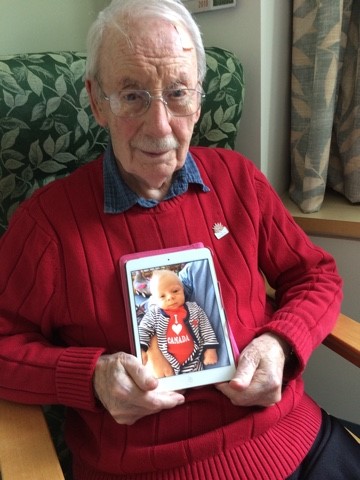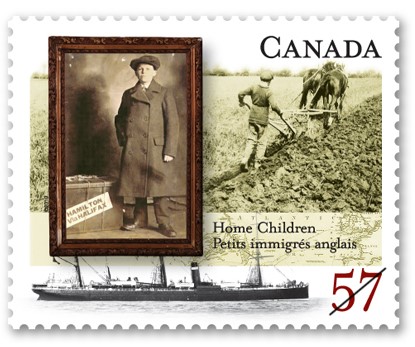Canada Remembers Times
Veterans’ Week Special Edition
5-11 November 2020 - Page 3
Young Canadians remember
Salma Khattab visiting a Canadian soldier’s grave in Italy.
Photo: Veterans Affairs Canada
Salma Khattab moved from Egypt to Canada with her family at a young age. In 2019 she travelled with a government delegation to Italy to commemorate the 75th anniversary of the Italian Campaign. As a new Canadian, she had often found it hard to connect with her new country’s efforts in the Second World War. However, her experience as a youth delegate gave her a whole new perspective:
Attending a remembrance ceremony with Veterans of the campaign, listening to their stories, is something I will always remember. Witnessing the Veterans’ pride as we promised to remember their contributions and the ultimate sacrifice that many of their comrades made, was a remarkable experience that I am thankful for every day. As for myself, I will always be grateful for their sacrifice and will forever remember what they did to protect the country that I now call home.
Hannah Yang, former student guide.
Photo: Veterans Affairs Canada
Hannah Yang worked in France as a student guide at the Canadian National Vimy Memorial and the Beaumont-Hamel Newfoundland Memorial in 2019. Being of South Korean descent, with no relatives who served in the First World War, she initially felt less qualified to represent Canada there. But over time, she realized she could not be more wrong:
Firstly, lessons learned from war are to be learned universally—no matter where you are from. Secondly, I learned I need to reflect on my own privilege as a second generation Canadian-Korean from the late 20th century. The Canada I live in today draws its identity from various things, one of which is undoubtedly this enormous world-wide conflict. Lastly, as part of Canada’s youth, I have the responsibility to share the stories of our Veterans with future generations. We must continue to preserve their memories so that we do not forget the lessons we learned from such horrific events.
Left: Kayden MacPhee
Right: Able Seaman Douglas Moore
Photos: Courtesy of David Douglas Moore
Kayden MacPhee does have a family member who had served in the Canadian military. His great-grandfather, Douglas Moore, was a sailor on HMCS Assiniboine during the Second World War. When Kayden’s Grade 11 class was studying the conflict, the teacher told the students if they dressed in wartime uniforms, they would get extra marks! Remembering his family military connection, Kayden called his grandfather to see if he still had any of great-grampie’s things from the war.
It turned out that almost everything had been saved, including a uniform Able Seaman Moore had worn when he was 19 years old, serving in the Royal Canadian Navy. Kayden received the uniform but was shocked by how tiny it was. Really wanting to honour his great-grandfather, he managed to squeeze into the wool suit—complete with jacket, pants and cap—and proudly wore it to school.
Protecting the skies over Europe
An RCAF Sabre at an airbase in France in 1953.
Photo: Department of National Defence
Canada was an important part of the North Atlantic Treaty Organization (NATO) forces that served in Western Europe during the Cold War. This military alliance helped protect the democratic countries of the west from the communist forces massed on the other side of the “Iron Curtain” in Eastern Europe from the late 1940s to the early 1990s.
Canadair F-86 Sabres were fast warplanes that for many years were the mainstays of Royal Canadian Air Force squadrons based in France and West Germany. They were the best jet fighters of the era and the pilots who flew Sabres were the “top guns” of their day.
More than 300 Canadian Sabres would streak across the skies of Western Europe between 1951 and 1963, helping guard against possible enemy attack. Thankfully, a full-scale war never erupted but it was still very dangerous duty. Some RCAF Sabre pilots would lose their lives during NATO training and patrol missions as they had to operate at a high tempo in all weather conditions.
The collapse of the communist regimes in Europe in the early 1990s meant that a major Canadian Armed Forces presence there was no longer necessary. We remember the brave Canadian aviators who helped protect our freedom during the darkest days of the Cold War.
What’s in a name?
Mr. Ludlow holding a photo of baby Tijl.
Submitted photo
The desire to honour Canadians who helped liberate their country during the Second World War runs deep in the people of the Netherlands. Remembrance is almost a part of the Dutch DNA—sometimes they even name their children after Canadian Veterans!
One Canadian who served in the Netherlands campaign, William G. Ludlow of Montréal, returned to the country for a visit 70 years later and stayed with a local couple in Apeldoorn named Henk and Olga. They became close with Mr. Ludlow and when they had their first child, Tijl, in the fall of 2017, they decided to give him the middle name Ludlow in honour of their friend and hero.
The new parents said they will explain the significance of his name when their child is old enough to understand that he “will be able to live in peace because of the sacrifice of the Canadian soldiers.”
British Home Children in service
Commemorative stamp launched in 2010.
Photo: Canada Post
Imagine leaving behind the only place you have ever known to come to a new land. For people who have immigrated to Canada—whether in years past or more recently—this was their reality. One special group who came to our country between the 1860s and the 1940s were the British Home Children.
More than 100,000 boys and girls from the United Kingdom were sent to Canada and they would make a lasting impact. British Home Children typically came from disadvantaged backgrounds —orphans or part of poor families that unfortunately could not support them. It was felt they would have an opportunity at building a better life in a young and fast-growing country like Canada.
The newcomers were usually sent to work on farms, with the boys toiling for long hours in the fields and the girls performing domestic duties while also helping out with other chores. Some children ended up in warm and supportive homes, but sadly many were not treated well.
When the First World War erupted in 1914, more than 10,000 former British Home Children would volunteer for military service. Often motivated by the chance to get back to the United Kingdom on their way to the front lines of Europe so they could hunt for lost family connections, they would serve bravely and make great sacrifices. At least 1,100 of them would lose their lives in the conflict.
Check out our new “British Home Children” web section.
Some Canadian military milestones

KOREAN WAR 1950-1953
- 25 June 1950 - Korean War begins
- 24-25 April 1951 - Canadians hold the line at Kapyong
- 27 July 1953 - Korean War Armistice signed
POST WAR EFFORTS 1950s-present
- 1956 - Canadian peacekeepers go to Egypt
- 1960 - Canadian peacekeepers arrive in the Congo
- 1964 - Canadian peacekeepers go to Cyprus
- 1974 - Canadian peacekeepers go to the Golan Heights
- 10 December 1988 - Nobel Peace Prize awarded to UN peacekeepers
- 1990-1991 - Canadians take part in the Gulf War
- September 1993 - Canadians fight at the Medak Pocket in Croatia
- 2000 - Canadian peacekeepers go to Ethiopia and Eritrea
- 2001-2014 - Canadians take part in the mission in Afghanistan
- 2018 - Canadian peacekeepers deploy to Mali
- Date modified:
